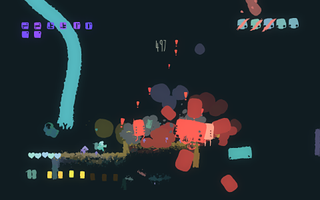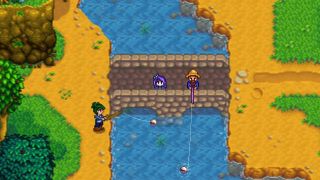Are indie games too cheap?
The average indie game on Steam costs less than $9 and sells few copies. Are those prices sustainable?

Eric Barone spent four years making Stardew Valley, teaching himself to code, to draw and redraw pixel art, to write characters and design a fun farming sim. For most of those four years he worked on it 10 hours a day, while also working part-time as a theater usher. Barone and his girlfriend scraped by on his part-time income and her grad school stipend. And after those four years of work, he released Stardew Valley on Steam for just 15 bucks.
For Barone, the pricing worked out—Stardew Valley has since sold around three million copies. But that's a success story few indie games can claim, and surprisingly, Stardew actually cost nearly twice the average price of indie games on Steam.
Steamspy creator Sergey Galyonkin, who by day is head of publishing for Epic Games in Eastern Europe, once claimed the average indie game is priced at $8.72 on Steam. And they sell few copies: the average number of sales is 21,000, a figure that's greatly distorted by big indie hits. And many of these are sold not at full price but during sales, when the average price halves to $4.63.
"The indie games are too damn cheap," he led his article, arguing that prices are unsustainable for many developers. He suggested that they should take advantage of their niche qualities: if a game has attracted a sale on the merits of its ideas, why not charge more? And he closed his argument with the final point, "If the game is worth the gamers' time, it's also worth their money."
In theoretical terms, it sounds like a strong argument. But in real terms, how does an indie developer think about pricing their game? How do they think about the number of other games that are releasing alongside theirs? Steam has over 30,000 games now, with roughly 8,000 new ones each year. With so many games now arriving on Steam, how do they stand to compete?
Why Heat Signature costs $15
We all know there are more games than ever before on Steam, and many of them are trying to use the competitive pricing card and price their games lower than they might have a couple years ago.
Andreea Chifu, Raw Fury
I'm good friends with Tom Francis, who used to work on PC Gamer before he left to finish his first game, Gunpoint, which he released in 2013. After a period thinking it'd be free, he asked the readers of his blog if he should charge money for it, and 99% of the comments agreed. He priced Gunpoint at $10, a figure he hoped would represent Gunpoint's three-hour playing time and feel "pleasantly low, so people would be pleased they got something of value." In part, though, it was informed by his lack of confidence in whether people would like his game, or that it had a wide breadth of appeal. $10 felt right.
Francis' next major game was Heat Signature, which he released in September. More experienced but unsure he could replicate the success of Gunpoint, he started to think about its price two years in advance, settling on three possible brackets: $10, $15 and $20. "I had a strong feeling it was worth more than Gunpoint, because if you like it, you'll get way more hours out of it," he told me.
Comic deals, prizes and latest news
Sign up to get the best content of the week, and great gaming deals, as picked by the editors.

But he knew his own opinion of the value of his game is irrelevant. "The only question that's relevant is how well it would do at these price points," he says. So once again he turned to his audience and in March he asked his beta players what they'd pay. The data he got back suggested that there was little real difference in revenue between pricing at $10 or $15. Fewer people would pay $15, but the additional $5 made up for the shortfall. He asked again in August, and the average figure came in $15, supporting Francis' own hunch for its value, so he felt fairly certain it would fit with prospective customers' sense of its worth.
The rising cost of production
Gunpoint and Heat Signature sit squarely in the standard pricing for indie games on Steam. But if Heat Signature only gained Steamspy's average number of sales, it would have netted Francis a loss. He spent $260,000 on its production, including paying an artist, a programmer and for music, and after Steam's cut, Francis would have a $43,000 overdraft to show for four years' work. Fortunately, Heat Signature is an excellent game, and he has a big enough following that it's sold comfortably above that level. But it shows the risk that developers face in ascribing fair-seeming prices to their games.
In general, small PC developers, small artists, authors and those kinds of creatives woefully underprice their products.
Economist Mark Bergen
Games like Gonner and Kingdom: New Lands are also in this pricing bracket, and their publisher, Raw Fury, takes into account production cost when considering prices. Head of sales and distribution Andreea Chifu tells me that they also consider competition, target audience, customer preferences and feedback from sales partners. And she feels the general pricing market might well be trending slightly downwards. "We all know there are more games than ever before on Steam, and many of them are trying to use the competitive pricing card and price their games lower than they might have a couple years ago. I personally don't think it helps so much, especially as production costs continue to rise."
The source of those costs, she says, are partly down to salary pressure: in Stockholm, where Chifu is based, game companies are struggling to retain talented staff. Partly it's down to inflation, which is not being reflected in game prices. And partly they're down to production costs, from freelancer rates and office space to software and equipment. She observes that Q.U.B.E. developer Toxic Games found the sequel cost more to develop than the first game. "So they had to make the sequel as cost-effective as possible and not pay themselves for a few months during that time. Which sadly is not uncommon in the games industry."

Why The Witness came with a premium price
At the top end of the indie pricing scale is The Witness, which was released January 2016 at $40. "It seemed like a big enough game, in terms of playtime and complexity, to warrant that price," lead developer Jonathan Blow tells me.
Blow's thinking behind it follows Galyonkin's argument precisely: "A higher price insulates against the danger that it might be a niche game, which was definitely a possibility in this case, because the game is so weird. If only a certain subset of gamers is going to be interested in your game, you won't necessarily reach more people by reducing the price, you may just lose support from the people who want to support you."
The choice appears to have been right for The Witness, since it sold better than Blow expected in its initial launch and continued to sell well afterwards. But he's not sure whether it proves Galyonkin right. "I don't know that $40 was the optimal price point," he says. "It may be that the game would have done even better at $30, but there's no way to know." And it can't be used as a model for other games because the games market is already so different today to what it was when The Witness came out.

The economic dimension
There's an easy economic argument to all this, of course: that it's a typical case of a market that has been disrupted by cheap tools like Unity and easy distribution like Steam, which have profoundly lowered the costs to entry, attracting more developers than the market can support. And then, free market economics being what is is, over time it'll normalise.
But when I spoke to Mark Bergen, an economist at the Carlson School of Management, University of Minnesota, it was clear that his sympathies lie with indie devs and that he values the effects of their freewheeling creativity on games as a whole. "In general, small PC developers, small artists, authors and those kinds of creatives woefully underprice their products," he told me. That's because, he argues, they tend to base their prices on cost of production. "And that intersects with people whose talents aren't pricing so they follow the herd, and like lemmings they're led over the cliff."

How indie devs can raise their prices
Instead, he says, they should instead be basing price on value. Value-based pricing is all about perceived value, not production value. It's how big brands work—how they charge more for common products, just because of their name. But for indies, value-based pricing is a scary prospect because it depends on convincing the world their game is special, and that's hard when most indies lack a recognised brand name and they're entering a market crowded with similar games.
The Witness managed it, though, and it did it by following one of Bergen's general strategies for going value-based: by focusing on making a high-quality, distinctive, long and feature-filled game. Easy, right? Of course, The Witness also had Blow's reputation behind it.
In games, perhaps the scarcity is players' time. And if that's right, perhaps an indie dev's real battle is to prove their game is worth time, rather than simply money.
There are other strategies. Indies could segment their offering, making differently priced versions to cater to different aspects of their market. This is something Tom Francis has done for both Gunpoint and Heat Signature, for which he offers a Supporters Edition for $30. Including soundtracks, early builds and videos in which he tells the story behind its development and at double the price, it's the fan-embracing edition, designed to allow them to support a game they liked, rather than specifically to raise value. During Heat Signature's initial release, the Supporters Edition represented 20 percent of its revenue.
There's behavioral pricing, which attempts to change attitudes towards value. Many customers will psychologically link a $10 game to other $10 games, but a $30 price might signal that it's better than the crowd. Alternatively, there's ‘Goldilocks pricing' which guides attitudes: make three versions, one cheap, one expensive, and many customers will plump for the one that feels just right in the middle. Or they could relate a game to its existing exemplars through its pricing. So they can advertise, say, a Civ-like game as 20% cheaper than Civilisation, rather than price it with the low price of other indie strategy games. (Maybe because he's an economist, Bergen is a big Civ fan.)
Or, finally, indie devs can think in terms of offering trials, cross-selling, a free version or paid DLC down the line, so the initial release is the start of a campaign designed to bring players in and get their money later on.
Time and money
Clearly, none of these strategies is easy. They all come with big risks. And besides, there's another argument to make about all this. Your Steam pile of shame is testament to a big constraint being not so much your money but your time to play them. When you consider a snap purchase, do you think about your wallet or whether you'll want to play it over your other games? When I propose this idea to Bergen, he's intrigued at how different the game market is to most others. Few industries are as interested in retaining customers' attention and time.
But he wonders if it relates to the ‘economics of stars,' which explains why player value at the top end of sports leagues rises so stratospherically high. In basketball, the quality of players is a smooth scale from the top to the bottom, but their value is heavily skewed towards the top. Here, the scarcity of the very best players collapses a fluid market of many prices in favour of a super-valuable high end. It's a winners' market: if you win, you win big.
In games, perhaps the scarcity is players' time. And if that's right, perhaps an indie dev's real battle is to prove their game is worth time, rather than simply money. Thinking about it this way might help to pull indie games out of a current market price which is unsustainably low for the numbers many sell. And that really does matter to us all. If creative developers can't make a living, that's not only bad for them, it's also bad for us. We lose an important layer of experimentation, and PC gaming as a whole suffers.
Most Popular




